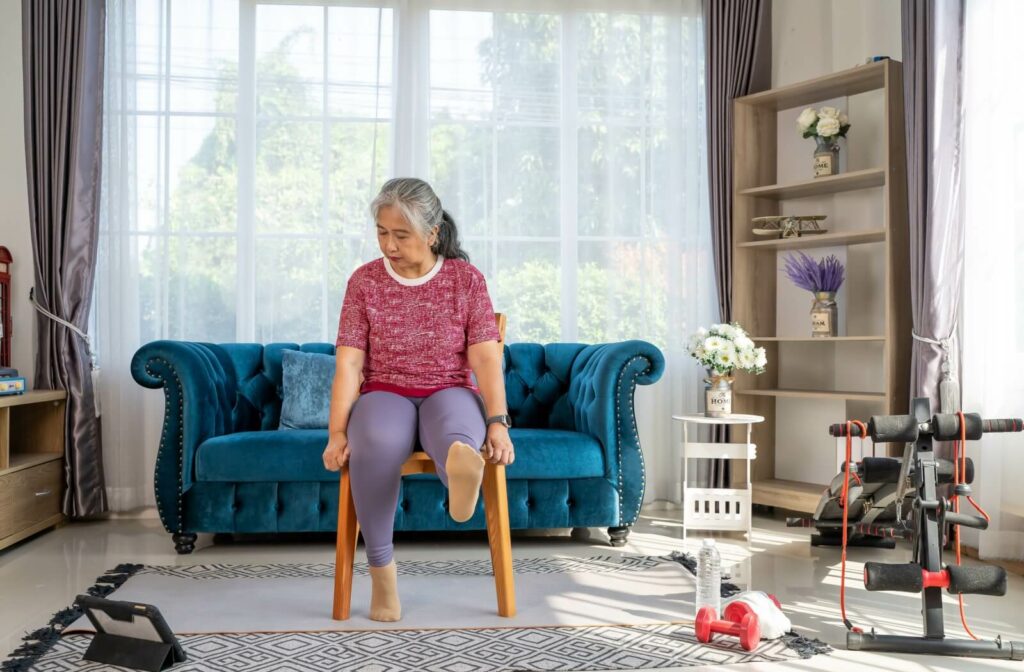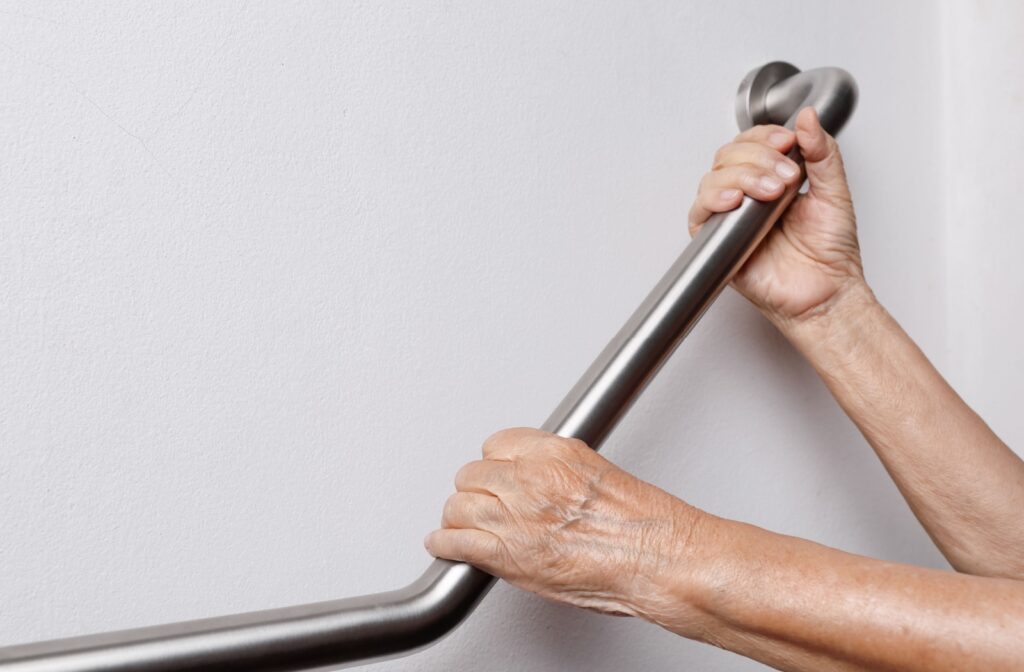Among older adults, falls account for a significant proportion of injuries, yet a number of these incidents can be avoided with the right preventive measures. The simple act of clearing obstructions, setting up handrails, and encouraging physical exercise can go a long way toward helping seniors stay safe within their living spaces.
Regardless of whether your loved one prefers an independent lifestyle or lives in a retirement community, implementing proactive safety precautions can minimize the risk of falls. By making minor changes, you can help make your loved one’s living space safer and easier to navigate.
Remove Tripping Hazards
Maintaining clutter-free living spaces is a straightforward and effective strategy for avoiding falls. Everyday household items such as loose rugs, cords, or accumulated clutter can rapidly transform into trip hazards, particularly for those with limited mobility or eyesight.
By keeping commonly used spaces such as lounges and corridors clear and tidy, you can reduce the likelihood of accidents.
Consider placing anti-slip mats in moisture-prone areas like bathrooms and kitchens. Remove potential obstacles from the living space, creating clear paths to promote smooth navigation from room to room. With these simple modifications, your loved one’s living environment can become significantly safer.
Improve Lighting Throughout the Home
Proper illumination is vital to avert accidents, particularly for the elderly who may struggle with deteriorating vision. Inadequate lighting can hinder visibility of hurdles, disparities in surfaces, or alterations in floor elevation, resulting in clumsy trips and falls. For heightened security, it’s essential to have all rooms, corridors and staircases brightly lit, especially after dark.
Consider the installation of nightlights in bedrooms, washrooms, and passageways to assist seniors with their nocturnal journeys. Lights equipped with motion sensors can prove advantageous too, illuminating automatically when motion is detected. Making sure that light switches are conveniently positioned and placed near entrances can significantly bolster safety and encourage self-reliance.
Install Grab Bars and Handrails
Staircases and bathrooms are somewhat notorious for being places where slips and falls might happen, particularly when there’s no firm support to grasp onto. Equipping these areas with grab bars – in your shower, alongside your toilet, or lining your hallways, can provide an added layer of support and stability to help prevent accidents. Correspondingly, ensuring that your stairways are outfitted with sturdy handrails on both sides can be a game-changer for maintaining balance while ascending or descending stairs.
When integrating these safety features, it’s crucial to guarantee that they’re solidly fastened to the wall and are composed of non-slip materials. These simple enhancements can substantially lessen the likelihood of an unfortunate tumble due to a loss of balance. This is particularly beneficial for the elderly, who may be more fragile or face mobility challenges.
Encourage Proper Footwear
Ensuring seniors sport suitable shoes is a key step towards bolstering their balance and preventing any unwelcome tumbles. It’s important that they opt for footwear that offers substantial support, features anti-slip soles, and fits correctly to minimize accident risks. While slippers and socks might feel cozy, they tend to increase the chances of slipping, particularly on wooden or tiled surfaces.
It’s advisable for the elderly to steer clear of footwear like flip-flops or high heels, leaning towards rubber-soled shoes instead. For those older individuals who find footwear management a challenge, adaptive shoes that are effortless to wear but still remain firm are a worthwhile contemplation. Making a thoughtful choice in footwear is a seemingly minor yet significantly effective measure towards averting falls.
Promote Physical Activity
Staying physically active is essential as it boosts strength, balance and coordination – key elements in preventing falls. It’s beneficial to persuade your elderly parent to partake in exercises that improve flexibility, strength and balance, like walking, swimming, or yoga. Don’t underestimate low-impact exercises, they play a significant role in preserving mobility and minimizing fall risks.
Numerous senior living communities present fitness programs specifically designed for older adults, offering an excellent opportunity to stay fit while enjoying social interaction. However, before kicking off any new fitness journey, seniors should get a green light from their doctor to ensure the activities suit their health status.
How Falls Affect Seniors

The impact of falls on senior citizens’ well-being can be crucial, touching both their physical and mental health. Following an unfortunate fall, the most pressing worry is the possibility of severe injuries like bone fractures, head injuries, or hip breakages. Such traumas often need a hospital stay followed by a prolonged rehabilitation period, reducing an elderly person’s freedom and agility for significant durations.
Moreover, falls can provoke a considerable dent in self-confidence. The fear of another fall makes many elderly individuals limit their regular pursuits or even avoid stepping out of their homes, causing a decrease in their overall activity levels. It can further result in social isolation, mental conditions like depression and lower physical fitness, thereby triggering a harmful cycle that amplifies the possibility of future falls.
For elderly individuals grappling with ongoing health issues like osteoporosis or arthritis, a fall can flare-up their pre-existing symptoms, making their recovery path more difficult. Such conditions debilitate the strength of bones and joints, heightening the risk of fractures or sprains even from minor falls. In certain situations, elderly individuals might not regain their former mobility or freedom levels, leading to the necessity for enhanced care or support.
Risk Factors for Falling as a Senior
Elderly individuals displaying the subsequent conditions have an elevated potential of experiencing a fall and consequent injury:
- Unsteady Gait or Instability: As muscle strength diminishes with age, it becomes challenging for seniors to retain or recover their balance when venturing onto uneven ground or accidental nudges.
- Diminished Vision: Aging affects our ability to gauge the relative position of objects, which may necessitate brighter light for unobstructed vision.
- Decreased Sensory Perception, Especially in the Feet: A reduction in sensory perception can hinder seniors’ ability to sense the ground, escalating the likelihood of a fall.
- Weakening Musculature: The erosion of muscle strength threatens balance and stability, enhancing the propensity for falls.
- Cognitive Decline: Cognitive depreciation could inhibit older adults from recalling vital safety precautions, such as gripping a handrail while negotiating stairs.
- Hypotension or Bradyarrhythmia: Low blood pressure or reduced heart rate may culminate in symptoms like dizziness, fainting, or blackouts, as cardiac issues limit the blood supply to the brain.
- Medication Usage: Specific prescriptions that impede attention (for example, opioids, anti-anxiety drugs, and certain antidepressants) or lower blood pressure (like antihypertensives, diuretics, and certain cardiac drugs) can amplify the fall risk.
Discover Assisted Living at Cedar Hills Senior Living
At Cedar Hills Senior Living, our primary focus is on ensuring the safety and wellness of our residents. We work to foster an environment where seniors can live life to the fullest with complete peace of mind. Our expert team is committed to delivering custom-tailored care and assistance to minimize the risk of falls and guarantee a secure, comfortable way of life.
Arrange a visit with us today to discover more about how we can bolster your loved one’s path towards a safe and enriching future.



